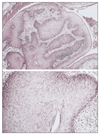Regression of deeply infiltrating giant condyloma (Buschke-Löwenstein tumor) following long-term intralesional interferon alfa therapy
- PMID: 10871930
- PMCID: PMC4921227
- DOI: 10.1001/archderm.136.6.707
Regression of deeply infiltrating giant condyloma (Buschke-Löwenstein tumor) following long-term intralesional interferon alfa therapy
Figures




Similar articles
-
Invasive squamous-cell carcinoma in giant anorectal condyloma (Buschke-Löwenstein tumor).Langenbecks Arch Chir. 1995;380(2):115-8. doi: 10.1007/BF00186418. Langenbecks Arch Chir. 1995. PMID: 7760649
-
[Malignant transformation of perianal Buschke-Löwenstein tumor. Extensive abdominoperineal rectum excision and reconstruction with transpelvic myocutaneous rectus abdominis muscle flap].Chirurg. 2002 Apr;73(4):370-4. doi: 10.1007/s00104-001-0402-4. Chirurg. 2002. PMID: 12063923 German.
-
[Buschke-Loewenstein tumor--a malignant condyloma].Chirurg. 1987 Dec;58(12):842-4. Chirurg. 1987. PMID: 3436205 German. No abstract available.
-
[Buschke-Löwenstein tumour: diagnosis and treatment].Ann Urol (Paris). 2006 Jun;40(3):175-8. doi: 10.1016/j.anuro.2006.02.002. Ann Urol (Paris). 2006. PMID: 16869538 Review. French.
-
Perianal giant condyloma acuminatum (Buschke-Löwenstein tumor). Case report and review of the literature.Chirurgia (Bucur). 2011 Jul-Aug;106(4):535-9. Chirurgia (Bucur). 2011. PMID: 21991883 Review.
Cited by
-
Clinicopathologic features of Buschke-Löwenstein tumor: a multi-institutional analysis of 38 cases.Virchows Arch. 2020 Apr;476(4):543-550. doi: 10.1007/s00428-019-02680-z. Epub 2019 Nov 15. Virchows Arch. 2020. PMID: 31728626
-
Fine scalpel surgery: preserving the dartos muscle in a patient with scrotal and perigenital giant Buschke-Löwenstein tumors.Wien Med Wochenschr. 2024 Nov;174(15-16):342-349. doi: 10.1007/s10354-024-01039-7. Epub 2024 Apr 8. Wien Med Wochenschr. 2024. PMID: 38587714 English.
-
The giant condyloma (buschke-löwenstein tumor) in the immunocompromised patient.Case Rep Obstet Gynecol. 2014;2014:793534. doi: 10.1155/2014/793534. Epub 2014 Sep 25. Case Rep Obstet Gynecol. 2014. PMID: 25328732 Free PMC article.
-
The Pathogenesis of Giant Condyloma Acuminatum (Buschke-Lowenstein Tumor): An Overview.Int J Mol Sci. 2022 Apr 20;23(9):4547. doi: 10.3390/ijms23094547. Int J Mol Sci. 2022. PMID: 35562936 Free PMC article. Review.
-
Buschke-Löwenstein Tumour: Successful Treatment with Minimally Invasive Techniques.Case Rep Dermatol Med. 2015;2015:651703. doi: 10.1155/2015/651703. Epub 2015 Aug 31. Case Rep Dermatol Med. 2015. PMID: 26417462 Free PMC article.
References
-
- Tieben LM, Berkhout RJ, Smits HL, et al. Detection of epidermodyplasia verruciformis-like human papillomavirus types in malignant and premalignant skin lesions of renal transplant recipients. Br J Dermatol. 1994;131:226–230. - PubMed
-
- Chu DC, Vezeridis MP, Libbey NP, Wanebo HJ. Giant condyloma acuminatum (Buschke-Loewenstein tumor) of the anorectal and perianal regions: analysis of 42 cases. Dis Colon Rectum. 1994;37:950–957. - PubMed
-
- Ilkay AK, Chodak GW, Vogelsang NJ, Gerber GS. Buschke-Loewenstein tumor: therapeutic options including systemic chemotherapy. Urology. 1993;42:599–601. - PubMed
-
- Zachariae H, Larsen PM, Sorgaard H. Recombinant interferon alpha -2a (Roferon-A) in a case of Buschke-Löwenstein giant condyloma. Dermatologica. 1988;177:175–179. - PubMed
-
- Tsambaos D, Monastirli A, Kapranos N, Georgiou S, Pasmatzi E, Berger H. Intralesional interferon alpha-2b therapy for Buschke-Loewenstein tumour. Acta Dermatol Venereol (Stockh) 1994;74:457–459. - PubMed
Publication types
MeSH terms
Substances
Grants and funding
LinkOut - more resources
Full Text Sources
Medical

